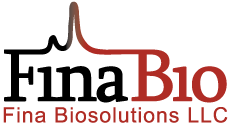
Fluorescent streptavidin-dextran conjugates are widely known as the gold standard for analyzing qualitative binding between T-cell receptors and T-cell antigens1-3. Fina Biosolutions offers rPE and APC-conjugated streptavidin-dextrans at competitive prices. Our fluorescent streptavidin-dextran conjugates use our well characterized 500 kDa amino dextran and have been extensively tested with live cells as well as PFA-fixed material. Streptavidin-dextrans with other fluorescent dyes can be prepared as custom products.
Multimers are used to stain T cells for flow cytometry and histology. The name stems from the docking of multiple biotinylated peptide-MHC molecules (pMHCs) onto a backbone. The backbone can be either a single fluorochrome-conjugated streptavidin molecule, which can bind up to 4 pMHCs (“tetramer”) or a fluorochrome-SA-dextran backbone. The highly multivalent presentation of tetramers on a flexible, hydrophilic polymer reveals low-affinity interactions.
References
- Dolton et al. Comparison of peptide-major histocompatibility complex tetramers and dextramers for the identification of antigen-specific T cells. Clin Exp Immunol. 117:47, 2014
- Bentzen & Hadrup. Evolution of MHC-based technologies used for detection of antigen-responsive T cells. Cancer Immunol Immunother. 66:657, 2017
- Bentzen et al. T cell receptor fingerprinting enables in-depth characterization of the interactions governing recognition of peptide–MHC complexes. Nature Biotechnology 36:1191, 2018




